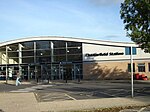Church of St Mary and All Saints, Chesterfield
Buildings and structures in Chesterfield, DerbyshireChurch of England church buildings in DerbyshireEngvarB from April 2014Grade I listed churches in DerbyshireInclined towers ... and 5 more
Incomplete lists from November 2008Major Churches NetworkTourist attractions of the Peak DistrictTowers completed in the 14th centuryTwisted buildings and structures

Chesterfield Parish Church is an Anglican church dedicated to Saint Mary and All Saints, in Chesterfield, Derbyshire, England. Building of the church began in 1234 AD, though the present church dates predominantly from the 14th century. Designated a Grade I listed building in 1971, St Mary's is best known for its twisted and leaning spire (known as the Crooked Spire). It is the largest parish church in the Diocese of Derby, and forms part of the Archdeaconry of Chesterfield. In 1994 it also became the UK's only representative in the Association of the Twisted Spires of Europe; of the 72 member churches, it is deemed to have the greatest lean and twist.
Excerpt from the Wikipedia article Church of St Mary and All Saints, Chesterfield (License: CC BY-SA 3.0, Authors, Images).Church of St Mary and All Saints, Chesterfield
Swan Yard,
Geographical coordinates (GPS) Address Website External links Nearby Places Show on map
Geographical coordinates (GPS)
| Latitude | Longitude |
|---|---|
| N 53.2361 ° | E -1.4241 ° |
Address
Parish Church of St Mary and All Saints
Swan Yard
S41 7TD , Stonegravels
England, United Kingdom
Open on Google Maps










